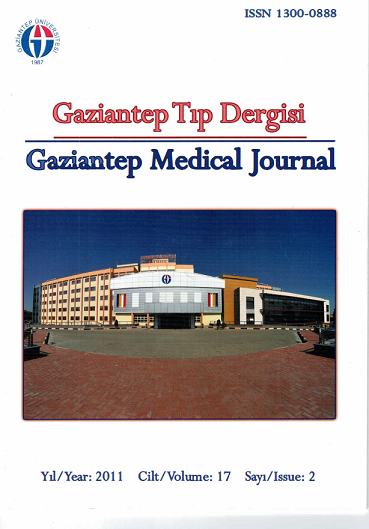The study of electrophysiological changes in nerve conduction of upper extremities in female volleyball players
Bayan voleybolcuların üst ekstremite sinirleri iletilerindeki elektrofizyolojik değişiklikler
DOI:
https://doi.org/10.5455/GMJ-30-2011-25Keywords:
Electrophysiology, nerve conduction, volleyballAbstract
This study was conducted to see the influence of the upper extremity movements on the electrophysiological changes on nerve conduction of upper extremities in female volleyball players. Twenty female volleyball players and 20 healthy females, not doing sports, were included in this study. All participants were healthy and right-handed. Bilateral median, ulnar, and radial nerves conduction studies were carried out and statistically evaluated. In volleyball players, right median motor distal latency (MDL) and F wave latency (FWL) were found to be faster (p<0.05 and p<0.001 respectively); and motor conduction velocity (MCV) was slower (p<0.01). In volleyball players, the right median 1st finger sensory conduction velocity (SCV) was found to be slower (p<0.05). The right ulnar MDL and FDL were found to be faster (p<0.001); and the elbow region MCV was to be slower (p<0.05). The right radial SCV of volleyball players were slower (p<0.05). In volleyball players, the left median MDL and FWL were faster (p<0.05 and p<0.001 respectively), and MCV were slower (p<0.01). The left ulnar MDL and FDL were found to be faster (p<0.05 and p<0.01 respectively). The study revealed that the right median and ulnar nerve MCV, SCV, FWL and radial sensory conductions as well as the left median and ulnar MDL and FWL were affected in volleyball players. These results reveal that volleyball can affect nerve conduction velocities especially in the dominant arms.
Metrics
References
Özbek A, Bamaç B, Budak F, Yenigün N, Çolak T. Nerve conduction study of ulnar nerve in volleyball players. Scand J Med Sci Sports 2006;16(3):197-200.
Çolak T, Bamaç B, Özbek A, Budak F, Bamaç YS. Nerve conduction studies of upper extremites in tennis players. Br J Sports Med 2004;38(5):632-5.
Preston CD, Shapiro BE. Electromyography and neuromuscular disorders. Clinical and electrophysiological correlations. Boston: Utterworth-Heinermann, 1988;103-20.
Meriç F. Upper and lower extremity nerve conduction and EMG potential differences in students of School of Physical Education and Sports, M.Sc. Thesis, Malatya, İnönü University, Graduate School of Health Sciences, 1999.
Bromberg MB, Jaros L. Symmetry of normal motor and sensory nerve conduction measurements. Muscle Nerve 1998; 21(4): 498-503.
Ertekin C. Central and Peripheral EMG. İzmir, Meta Basım Matbaacılık, 2006; 108.
Downloads
Published
How to Cite
Issue
Section
License
Copyright (c) 2023 European Journal of Therapeutics

This work is licensed under a Creative Commons Attribution-NonCommercial 4.0 International License.
The content of this journal is licensed under a Creative Commons Attribution-NonCommercial 4.0 International License.


















